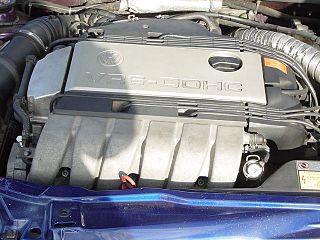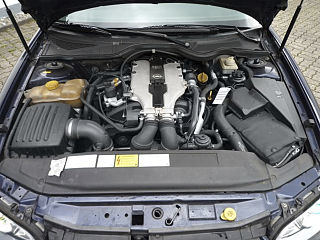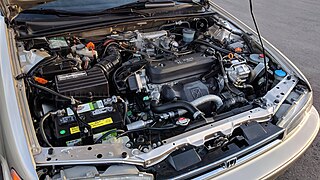
In an internal combustion engine, the cylinder head sits above the cylinders and forms the roof of the combustion chamber. In sidevalve engines, the head is a simple sheet of metal; whereas in more modern overhead valve and overhead camshaft engines, the cylinder head is a more complicated block often containing inlet and exhaust passages, coolant passages, valves, camshafts, spark plugs and fuel injectors. Most straight engines have a single cylinder head shared by all of the cylinders and most V engines have two cylinder heads.
A W8 engine is an eight-cylinder piston engine with four banks of two cylinders each, arranged in a W configuration.

The VR6 engine is a 6-cylinder engine configuration developed by VW. The name VR6 comes from the combination of German words “Verkürzt” and “Reihenmotor” meaning “shortened inline engine”. It was developed specifically for transverse engine installations and FWD vehicles. The VR6 is a highly compact engine, thanks to the narrower angle of 10.5 to 15-degrees between cylinder banks, as opposed to the traditional V6 angles ranging from 45 to 90-degrees. The compact design is cheaper to manufacture, since only one cylinder head is required for all 6 cylinders, much like a traditional inline-6 engine.

General Motors' Opel subsidiary in Europe designed a compact V6 engine with an unusual 54° vee angle. It was an iron block/aluminum head DOHC design with four valves per cylinder. All 54° engines were assembled at Ellesmere Port in England.

The Lamborghini V10 is a ninety degree (90°) V10 petrol engine which was developed for the Lamborghini Gallardo automobile, first sold in 2003.
Jetronic is a trade name of a manifold injection technology for automotive petrol engines, developed and marketed by Robert Bosch GmbH from the 1960s onwards. Bosch licensed the concept to many automobile manufacturers. There are several variations of the technology offering technological development and refinement.

The Honda F-Series engine was considered Honda's "big block" SOHC inline four, though lower production DOHC versions of the F-series were built. It features a solid iron or aluminum open deck cast iron sleeved block and aluminum/magnesium cylinder head.

An engine control unit (ECU), also called an engine control module (ECM), is a device which controls multiple systems of an internal combustion engine in a single unit. Systems commonly controlled by an ECU include the fuel injection and ignition systems.

Motronic is the trade name given to a range of digital engine control units developed by Robert Bosch GmbH which combined control of fuel injection and ignition in a single unit. By controlling both major systems in a single unit, many aspects of the engine's characteristics can be improved.
A throttle is a mechanism by which fluid flow is managed by constriction or obstruction.
A V5 engine is a five-cylinder piston engine where the cylinders share a common crankshaft and are arranged in a V configuration.

In a spark ignition internal combustion engine, ignition timing is the timing, relative to the current piston position and crankshaft angle, of the release of a spark in the combustion chamber near the end of the compression stroke.

The EA827 family of petrol engines was initially developed by Audi under Ludwig Kraus leadership and introduced in 1972 by the B1-series Audi 80, and went on to power many Volkswagen Group models. This is a very robust water-cooled engine configuration for four- up to eight- cylinders. In Brazil this engine was produced under the name Volkswagen AP AP.
Manifold injection is a mixture formation system for internal combustion engines with external mixture formation. It is commonly used in engines with spark ignition that use petrol as fuel, such as the Otto engine, and the Wankel engine. In a manifold-injected engine, the fuel is injected into the intake manifold, where it begins forming a combustible air-fuel mixture with the air. As soon as the intake valve opens, the piston starts sucking in the still forming mixture. Usually, this mixture is relatively homogeneous, and, at least in production engines for passenger cars, approximately stoichiometric; this means that there is an even distribution of fuel and air across the combustion chamber, and enough, but not more air present than what is required for the fuel's complete combustion. The injection timing and measuring of the fuel amount can be controlled either mechanically, or electronically. Since the 1970s and 1980s, manifold injection has been replacing carburettors in passenger cars. However, since the late 1990s, car manufacturers have started using petrol direct injection, which caused a decline in manifold injection installation in newly produced cars.

Volkswagen Group have produced a number of W12 internal combustion piston engines for their Volkswagen, Audi, and Bentley marques, since 2001.

The Volkswagen-Audi V8 engine family is a series of mechanically similar, gasoline-powered and diesel-powered, V-8, internal combustion piston engines, developed and produced by the Volkswagen Group, in partnership with Audi, since 1988. They have been used in various Volkswagen Group models, and by numerous Volkswagen-owned companies. The first spark-ignition gasoline V-8 engine configuration was used in the 1988 Audi V8 model; and the first compression-ignition diesel V8 engine configuration was used in the 1999 Audi A8 3.3 TDI Quattro. The V8 gasoline and diesel engines have been used in most Audi, Volkswagen, Porsche, Bentley, and Lamborghini models ever since. The larger-displacement diesel V8 engine configuration has also been used in various Scania commercial vehicles; such as in trucks, buses, and marine (boat) applications.










